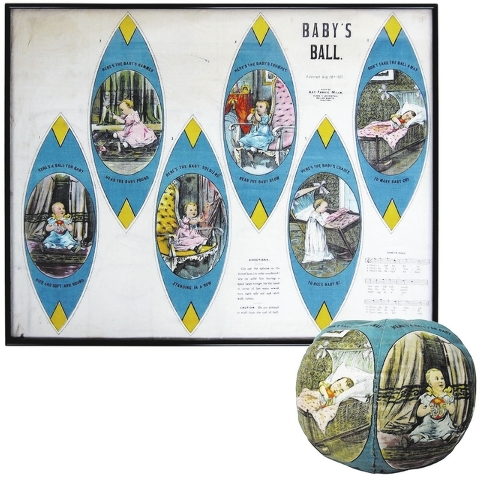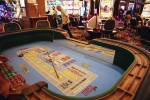Victorian-era sewers toyed with fabrics
Our Victorian ancestors made many of the toys their children played with. Inexpensive printed fabrics were designed to be cut out and sewn into dolls, games or toys. The fabric usually pictured all the parts of a colorful toy. There also were printed instructions explaining how to assemble the pieces and, if necessary, how to stuff it.
We have seen stuffed Christmas stockings made from prints that featured Santa, evergreens and other Christmas decorations. There were many versions of “Pin the Tail on the Donkey.” A similar game made in about 1900, called “The Monkey Donation Party Game,” was made from a white fabric with a black printed monkey holding a stitched-on circular piece with the words “Please put a penny in the cap.”
During the first quarter of the 20th century, many manufactured fabrics could be made into advertising dolls. Printed fabric was inexpensive to make and to mail. An unusual printed toy of that period is a ball made of six colored oval pieces. Each piece pictures a baby holding a finished ball. It was made in 1900 by Art Fabric Mills, and the fabric included printed instructions and the words and music of a lullaby.
A collector recently paid $165 for a homemade ball in unfaded condition, but the uncut pattern sells for more — about $200 to $300. A flat piece of fabric can be framed and displayed on a wall. The assembled ball is less decorative.
Q: I recently acquired a vintage dining room table, one table leaf and five matching chairs. The wood is walnut, and the table is very ornate. We found a paper label on two of the chairs. It reads “Midwest Furniture &Chair Co.” I can’t find any information about the company. And what could the set be worth?
A: Midwest Furniture &Chair Co. was in business in St. Joseph, Mo., in the 1920s. Your set would be worth more if you had a sixth chair. Sets by the same maker have sold recently for $450 and $675, but both had at least six chairs plus a sideboard or buffet. So your table and five chairs might sell for $200 or less.
Q: I have a letter opener that reads “Pan-American Exposition, 1901” on the blade and a picture of the fair’s Electric Tower on the handle. The back has fruit and flower designs. It’s silver colored, but I’m not sure if it’s sterling silver. Does it have any value?
A: The Pan-American Exposition was held in Buffalo, N.Y., from May to November 1901. Many souvenir items were made picturing the buildings and other features of the fair. The Electric Tower pictured on your letter opener was the tallest structure at the fair and was often pictured.
Most souvenir items are silver plate, not sterling silver. Your letter opener is probably worth about $25.
Here’s a little history: President William McKinley was shot by anarchist Leon Czolgosz while the president was shaking hands with visitors in the Temple of Music on the fairgrounds on Sept. 6, 1901. He died eight days later.
For more information about the 1901 World’s Fair, go to PanAm1901.org.
Q: A few years ago, I was at a garage sale and spotted a bronze-colored bust of a classical woman. I instantly fell in love with her. She’s imprinted on the back with the artist’s signature, “Henri Jacobs,” and “copyright 1904 by Napoleon Alliot.” I would like to know more about the maker of this bust.
A: Henri Jacobs (1864-1935) has been called the father of Belgian art nouveau. He was an artist and architect and was also known for his art nouveau busts of women. Napoleon Alliot was a sculptor who also had a foundry.
Your bust could sell at auction for more than $1,000 even though it is not bronze.
Q: When the floor of our AmVets Post in Perry, Ohio, was replaced, we found a bottle with the words “Fairport Bottling Works, M. Killinen, Prop.” in raised letters. The bottle was covered in dirt but is clear glass. The top is broken off, but it will still make a nice vase once the jagged part is cut off or ground down. I don’t think it has value, but I’d like to know how old it is and where it’s from. Our post meets in an old building that I think was an ice house around the time of the Civil War, so the bottle may date from the mid- to late-1800s.
A: Matt Killinen, the business proprietor whose name is on the bottle, emigrated from Finland in 1887 and settled in Fairport, Ohio. He founded the Fairport Bottling Works in about 1894 and was in business until at least 1913. The company sold soft drinks throughout northeastern Ohio.
Q: I have come across a “Grimm Cover,” which apparently is some sort of commode or potty or “thunder-mug” cover. It’s made of galvanized steel and is embossed “Grimm Cover, Patented July 19, 1804.” Have you ever seen another one?
A: You actually have a sap bucket cover, not a commode cover. A patent for a “new and improved sap-spout and cover” was granted to G.H. Grimm in 1904 (not 1804). His newly designed spout and cover made it possible to pour sap without removing the bucket from the hook that attached it to the tree. The covers were made in two sizes, 12 and 14 inches. It’s not clear how many years they were made, but they were still in Grimm’s catalog in 1912.
We have seen several Grimm’s Covers advertised online. They sell for less than $10 each.
CURRENT PRICES
Current prices are recorded from antiques shows, flea markets, sales and auctions throughout the United States. Prices vary in different locations because of local economic conditions.
■ Hen-on-nest covered dish, amber glass, hobnail rim, Indiana Glass Co., 5¼ by 7 by 5½ inches, $15.
■ Tilt-top table, maple, turned pedestal, 3 slipper feet, 26 inches by 23 inches, $140.
■ Fire chief toy car, tin, friction, Louis Marx, 20 inches, $170.
■ Imari pattern dessert plates, Aynsley China, 8 inches, 12 pieces, $190.
■ Day dress, shot silk, pleated bodice, green, teal fringe, lined, c. 1840, $385.
■ Amos &Andy Fresh Air Taxi, tin lithograph, clockwork, Marx, 8 inches, $650.
■ Shearwater Pottery cat, seated, Walter Anderson, 10½ by 10¾ inches, $800.
■ Rooster windmill weight, cast iron, old red paint, Elgin Wind Power &Pump Co., c. 1900, 16 by 16 inches, $805.
■ King Cole Tea &Coffee door push, porcelain, lithographed, 3 by 8 inches, $1,420
■ Rococo-style commode, painted, red and green flowers, yellow ground, two drawers, 35 by 52 inches, $3,440.
Terry Kovel’s column is syndicated by King Features. Write to: Kovels, (Las Vegas Review-Journal), King Features Syndicate, 300 W. 57th St., New York, NY 10019.




























